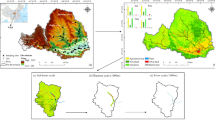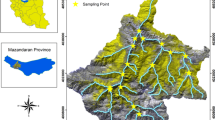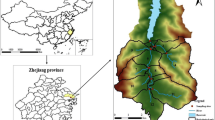Abstract
Understanding the complexity of catchment-scale human activities, natural factors, and stream water quality is particularly important for basin water resources management. Thorough investigations on how multiple environmental factors quantitatively and simultaneously affect water quality are limited. This study employed Spearman’s correlation and ridge regression analysis (RRA) to disentangle the hydraulic geometry and land use contributions to water quality variables (WQVs). Nine and six indicators were used to describe the hydraulic geometry and land use characteristics, respectively, in the Taihu Basin. The results revealed significant correlations between the land use, hydraulic geometry, and stream water quality. Built-up land and cropland negatively impacted the stream water quality, while woodland had the opposite trend. The structure and morphological connectivity of the river network were associated with most WQVs. The hydrologic connectivity characteristics strongly influenced ammonia–nitrogen (NH3-N), permanganate index (CODMn), and dissolved oxygen (DO). Six equations that estimated the stream water quality were established through RRA. Human factors impose a greater impact on the stream water quality than natural factors in the Taihu Basin. Our findings provide quantitative insights to mitigate water pollution via reasonable management and control of the river structure and connectivity and land-use patterns.









Similar content being viewed by others
Data availability
The precipitation and air temperature data used in this study are freely available at the National Meteorological Information Center of the China Meteorological Administration (http://data.cma.cn/). The water quality data and streamflow data used in the study are provided by the Water Resources Conservation Bureau, Taihu Basin Authority of Ministry of Water Resources. Water quality data analyzed during this study are summarized in this published article and its electronic supplementary information material. The river network data and land use data are provided by the Institute of Geographic Sciences and Natural Resources Research, Chinese Academy of Sciences. Datasets will be made available from the corresponding author on reasonable request.
References
Ahn, J.J., Kim, Y.M., Yoo, K., Park, J., & Oh, K.J. (2012). Using GA-Ridge regression to select hydro-geological parameters influencing groundwater pollution vulnerability. Environmental Monitoring and Assessment, 184(11), 6637–6645.
Ai, L., Shi, Z.H., Yin, W., & Huang, X. (2015). Spatial and seasonal patterns in stream water contamination across mountainous watersheds: Linkage with landscape characteristics. Journal of Hydrology, 523, 398–408.
Arocena, R., Chalar, G., & Pablo Pacheco, J. (2018). Agriculture and elevation are the main factors for Pampasic stream habitat and water quality. Environmental Monitoring and Assessment, 190(4).
Beaulieu, J.J., Golden, H.E., Knightes, C.D., Mayer, P.M., Kaushal, S.S., Pennino, M.J., et al. (2015). Urban stream burial increases watershed-scale nitrate export. Plos One, 10(7).
Berka, C., Schreier, H., & Hall, K. (2001). Linking water quality with agricultural intensification in a rural watershed. Water Air and Soil Pollution, 127(1–4), 389–401.
Bostanmaneshrad, F., Partani, S., Noori, R., Nachtnebel, H.P., Berndtsson, R., & Adamowski, J.F. (2018). Relationship between water quality and macro-scale parameters (land use, erosion, geology, and population density) in the Siminehrood River Basin. Science of the Total Environment, 639, 1588–1600.
Bu, H., Meng, W., Zhang, Y., & Wan, J. (2014). Relationships between land use patterns and water quality in the Taizi River basin, China. Ecological Indicators, 41, 187–197.
Cai, Y., Zhao, D., Xu, D., Jiang, H., Yu, M., Leng, X., et al. (2015). Influences of land use on sediment pollution across multiple spatial scales in Taihu Basin. Clean-Soil Air Water, 43(12), 1616–1622.
Che, Y., Li, W., Shang, Z., Liu, C., & Yang, K. (2014). Residential preferences for river network improvement: An exploration of choice experiments in Zhujiajiao, Shanghai. China. Environmental Management, 54(3), 517–530.
Chen, L.D., Fu, B.J., Zhang, S.R., Qiu, J., Guo, X.D., & Yang, F.L. (2002). A comparative study on nitrogen-concentration dynamics in surface water in a heterogeneous landscape. Environmental Geology, 42(4), 424–432.
Cheng, F.Y., & Basu, N.B. (2017). Biogeochemical hotspots: Role of small water bodies in landscape nutrient processing. Water Resources Research, 53(6), 5038–5056.
Covino, T. (2017). Hydrologic connectivity as a framework for understanding biogeochemical flux through watersheds and along fluvial networks. Geomorphology, 277, 133–144.
De Mello, K., Valente, R.A., Randhir, T.O., dos Santos, A.C.A., & Vettorazzi, C.A. (2018). Effects of land use and land cover on water quality of low-order streams in Southeastern Brazil: Watershed versus riparian zone. Catena, 167, 130–138.
Delpla, I., Jung, A.V., Baures, E., Clement, M., & Thomas, O. (2009). Impacts of climate change on surface water quality in relation to drinking water production. Environment International, 35(8), 1225–1233.
Deng, X.J. (2019). Correlations between water quality and the structure and connectivity of the river network in the Southern Jiangsu Plain, Eastern China. Science of the Total Environment, 664, 583–594.
Deng, X.J., Xu, Y.P., & Han, L.F. (2018). Impacts of human activities on the structural and functional connectivity of a river network in the Taihu Plain. Land Degradation & Development, 29(8), 2575–2588.
Fatehi, I., Amiri, B.J., Alizadeh, A., & Adamowski, J. (2015). Modeling the relationship between catchment attributes and in-stream water quality. Water Resources Management, 29(14), 5055–5072.
Fiquepron, J., Garcia, S., & Stenger, A. (2013). Land use impact on water quality: Valuing forest services in terms of the water supply sector. Journal of Environmental Management, 126, 113–121.
Gong, X., Bian, J., Wang, Y., Jia, Z., & Wan, H. (2019). Evaluating and predicting the effects of land use changes on water quality using SWAT and CA-Markov models. Water Resources Management, 33(14), 4923–4938.
Gonzales-Inca, C.A., Kalliola, R., Kirkkala, T., & Lepisto, A. (2015). Multiscale landscape pattern affecting on stream water quality in agricultural watershed. SW Finland. Water Resources Management, 29(5), 1669–1682.
Haidary, A., Amiri, B.J., Adamowski, J., Fohrer, N., & Nakane, K. (2013). Assessing the impacts of four land use types on the water quality of wetlands in Japan. Water Resources Management, 27(7), 2217–2229.
Han, L.F., Xu, Y.P., Lei, C.G., Yang, L., Deng, X.J., Hu, C.S., et al. (2016). Degrading river network due to urbanization in Yangtze River Delta. Journal of Geographical Sciences, 26(6), 694–706.
Harvey, J., Gomez-Velez, J., Schmadel, N., Scott, D., Boyer, E., Alexander, R., et al. (2019). How hydrologic connectivity regulates water quality in river corridors. Journal of the American Water Resources Association, 55(2), 369–381.
Helton, A.M., Hall, R.O., & Bertuzzo, E. (2018). How network structure can affect nitrogen removal by streams. Freshwater Biology, 63(1), 128–140.
Hoerl, A.E., & Kennard, R.W. (2000). Ridge regression: Biased estimation for nonorthogonal problems. Technometrics, 42(1), 80–86.
Hooke, J. (2003). Coarse sediment connectivity in river channel systems: A conceptual framework and methodology. Geomorphology, 56, 79–94.
Kalinin, A., Covino, T., & McGlynn, B. (2016). The influence of an in-network lake on the timing, form, and magnitude of downstream dissolved organic carbon and nutrient flux. Water Resources Research, 52(11), 8668–8684.
Kang, J.H., Lee, S.W., Cho, K.H., Ki, S.J., Cha, S.M., & Kim, J.H. (2010). Linking land-use type and stream water quality using spatial data of fecal indicator bacteria and heavy metals in the Yeongsan river basin. Water Research, 44(14), 4143–4157.
Kondolf, G.M., Boulton, A.J., O’Daniel, S., Poole, G.C., Rachel, F.J., Stanley, E.H., et al. (2006). Process-based ecological river restoration: Visualizing three-dimensional connectivity and dynamic vectors to recover lost linkages. Ecology and Society, 11(2).
Lassaletta, L., Garcia-Gomez, H., Gimeno, B.S., & Rovira, J.V. (2009). Agriculture-induced increase in nitrate concentrations in stream waters of a large Mediterranean catchment over 25 years (1981–2005). Science of the Total Environment, 407(23), 6034–6043.
Lee, S.W., Hwang, S.J., Lee, S.B., Hwang, H.S., & Sung, H.C. (2009). Landscape ecological approach to the relationships of land use patterns in watersheds to water quality characteristics. Landscape and Urban Planning, 92(2), 80–89.
Mao, F., Zhao, X., Ma, P., Chi, S., Richards, K., Hannah, D.M., et al. (2019). Revision of biological indices for aquatic systems: A ridge-regression solution. Ecological Indicators, 106.
Marcarelli, A.M., & Wurtsbaugh, W.A. (2007). Effects of upstream lakes and nutrient limitation on periphytic biomass and nitrogen fixation in oligotrophic, subalpine streams. Freshwater Biology, 52(11), 2211–2225.
Noges, T. (2009). Relationships between morphometry, geographic location and water quality parameters of European lakes. Hydrobiologia, 633(1), 33–43.
Pennino, M.J., Kaushal, S.S., Beaulieu, J.J., Mayer, P.M., & Arango, C.P. (2014). Effects of urban stream burial on nitrogen uptake and ecosystem metabolism: Implications for watershed nitrogen and carbon fluxes. Biogeochemistry, 121(1), 247–269.
Pieterse, N.M., Bleuten, W., & Jorgensen, S.E. (2003). Contribution of point sources and diffuse sources to nitrogen and phosphorus loads in lowland river tributaries. Journal of Hydrology, 271(1–4), 213–225.
Powers, S.M., Robertson, D.M., & Stanley, E.H. (2014). Effects of lakes and reservoirs on annual river nitrogen, phosphorus, and sediment export in agricultural and forested landscapes. Hydrological Processes, 28(24), 5919–5937.
Prathumratana, L., Sthiannopkao, S., & Kim, K.W. (2008). The relationship of climatic and hydrological parameters to surface water quality in the lower Mekong River. Environment International, 34(6), 860–866.
Pratt, B., & Chang, H.J. (2012). Effects of land cover, topography, and built structure on seasonal water quality at multiple spatial scales. Journal of Hazardous Materials, 209, 48–58.
Pringle, C. (2003). What is hydrologic connectivity and why is it ecologically important? Hydrological Processes, 17(13), 2685–2689.
Qin, B.Q., Xu, P.Z., Wu, Q.L., Luo, L.C., & Zhang, Y.L. (2007). Environmental issues of Lake Taihu, China. Hydrobiologia, 581, 3–14.
Raymond, P.A., Saiers, J.E., & Sobczak, W.V. (2016). Hydrological and biogeochemical controls on watershed dissolved organic matter transport: Pulse-shunt concept. Ecology, 97(1), 5–16.
Schwarzenbach, R.P., Egli, T., Hofstetter, T.B., von Gunten, U., & Wehrli, B. (2010). Global water pollution and human health. In D. M. Liverman (Ed.), Annual Review of Environment and Resources (Vol. 35, pp. 109–136). Palo Alto.
Shang, Z., Che, Y., Yang, K., & Jiang, Y. (2012). Assessing local communities’ willingness to pay for river network protection: A contingent valuation study of Shanghai, China. International Journal of Environmental Research and Public Health, 9(11), 3866–3882.
Shi, P., Zhang, Y., Li, Z., Li, P., & Xu, G. (2017). Influence of land use and land cover patterns on seasonal water quality at multi-spatial scales. Catena, 151, 182–190.
Shi, W., Xia, J., & Zhang, X. (2016). Influences of anthropogenic activities and topography on water quality in the highly regulated Huai River basin. China. Environmental Science and Pollution Research, 23(21), 21460–21474.
Steele, M.K., & Heffernan, J.B. (2014). Morphological characteristics of urban water bodies: Mechanisms of change and implications for ecosystem function. Ecological Applications, 24(5), 1070–1084.
Strahler, A.N. (1952). Hypsometric (area-altitude) analysis of erosional topography. Bulletin of the Geological Society of America, 63, 1117–1142.
Tang, Z., Engel, B.A., Pijanowski, B.C., & Lim, K.J. (2005). Forecasting land use change and its environmental impact at a watershed scale. Journal of Environmental Management, 76(1), 35–45.
Tran, C.P., Bode, R.W., Smith, A.J., & Kleppel, G.S. (2010). Land-use proximity as a basis for assessing stream water quality in New York State (USA). Ecological Indicators, 10(3), 727–733.
Vadde, K.K., Wang, J., Cao, L., Yuan, T., McCarthy, A.J., & Sekar, R. (2018). Assessment of water quality and identification of pollution risk locations in Tiaoxi River (Taihu Watershed), China. Water, 10(2).
Wan, R.R., Cai, S.S., Li, H.P., Yang, G.S., Li, Z.F., & Nie, X.F. (2014). Inferring land use and land cover impact on stream water quality using a Bayesian hierarchical modeling approach in the Xitiaoxi River Watershed, China. Journal of Environmental Management, 133, 1–11.
Wollheim, W.M., Bernal, S., Burns, D.A., Czuba, J.A., Driscoll, C.T., Hansen, A.T., et al. (2018). River network saturation concept: Factors influencing the balance of biogeochemical supply and demand of river networks. Biogeochemistry, 141(3), 503–521.
Yang, L., Xu, Y.P., Han, L.F., Song, S., Deng, X.J., & Wang, Y.F. (2016). River networks system changes and its impact on storage and flood control capacity under rapid urbanization. Hydrological Processes, 30(13), 2401–2412.
Yu, X., Hawley-Howard, J., Pitt, A.L., Wang, J.J., Baldwin, R.F., & Chow, A.T. (2015). Water quality of small seasonal wetlands in the Piedmont ecoregion, South Carolina, USA: Effects of land use and hydrological connectivity. Water Research, 73, 98–108.
Zampella, R.A., Procopio, N.A., Lathrop, R.G., & Dow, C.L. (2007). Relationship of land-use/land-cover patterns and surface-water quality in the Mullica River basin. Journal of the American Water Resources Association, 43(3), 594–604.
Zhao, H.X., Duan, X.J., Stewart, B., You, B.S., & Jiang, X.W. (2013). Spatial correlations between urbanization and river water pollution in the heavily polluted area of Taihu Lake Basin. China. Journal of Geographical Sciences, 23(4), 735–752.
Zhao, J., Lin, L., Yang, K., Liu, Q., & Qian, G. (2015). Influences of land use on water quality in a reticular river network area: A case study in Shanghai, China. Landscape and Urban Planning, 137, 20–29.
Zhu, H., Ren, X., Jin, Y., Yang, K., & Che, Y. (2015). Multilevel analysis of a riverscape under rapid urbanization in the Yangtze delta plain, China: 1965–2006. Environmental Monitoring and Assessment, 187(11).
Funding
This study is supported by the China Postdoctoral Science Foundation (Grant No. 2019M661422).
Author information
Authors and Affiliations
Corresponding author
Ethics declarations
Conflict of interest
The authors declare no competing interests.
Additional information
Publisher's Note
Springer Nature remains neutral with regard to jurisdictional claims in published maps and institutional affiliations.
Supplementary Information
Below is the link to the electronic supplementary material.
Rights and permissions
About this article
Cite this article
Liu, Y., Zhang, H., Zeng, P. et al. Linking hydraulic geometry, land use, and stream water quality in the Taihu Basin, China. Environ Monit Assess 193, 484 (2021). https://doi.org/10.1007/s10661-021-09270-0
Received:
Accepted:
Published:
DOI: https://doi.org/10.1007/s10661-021-09270-0




